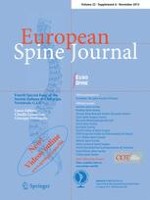01-11-2013 | Original Article
Sagittal balance in adolescent idiopathic scoliosis: radiographic study of spino-pelvic compensation after surgery
Published in: European Spine Journal | Special Issue 6/2013
Login to get accessAbstract
Study design
Radiographic retrospective study of a consecutive series of 76 patients with adolescent idiopathic scoliosis (AIS) undergoing posterior only surgical correction and fusion.
Objective
To evaluate the sagittal profile changes in a population of adolescent idiopathic scoliosis after posterior only surgical correction.
Summary of background data
Although the relationship between pelvic indexes and sagittal profile is well known, little has been published about the sagittal profile changes after posterior surgery in adolescent idiopathic scoliosis.
Methods
Radiological data of 76 AIS patients were analyzed by an independent observer to compare pelvic indexes and spino-pelvic parameters before and at the last follow-up after surgical posterior correction. All patients underwent a posterior only surgical correction by using different anchor techniques (all screws or hybrid construct), but the same derotation correction maneuver (C-D technique). The collected data were analyzed, on AP and LL radiographic views of the entire spine in the upright position, from the same independent observer and using the same Impax software analysis. We collected for each patient on latero-lateral X-rays the following data: pelvic incidence (PI), pelvic tilt (PT), sacral slope (SS), lumbar lordosis (LL), thoracic kyphosis (TK), C7 plumb line (C7PL) and spino-sacral angle (SSA). All data were analyzed using a D’Agostino–Pearson normality test and the comparison between the groups was performed with a student’s t test.
Results
The mean pelvic incidence (PI) of the cohort was 48.89° (±11.24), with a mean Cobb angle for the main curve of 60.13° (±13.6). The mean value of residual scoliosis after surgery was 28.18° (±13.22) with an average improvement of the curve in the frontal plane of 53.2 %. The amount of curve correction of the primary scoliosis curve was statistically significant (p < 0.0001). In the evaluation of the whole group after surgery, we observed an increasing amount of PT (average delta value 2.38°) with a statistical significance (p = 0.0034). If we compare the mean ideal PT value (11.09°) with the pre- and post-operative mean true PT values, we found statistical significance only for the post-operative difference (p = 0.0014). In the general assessment, C7PL seems to remain stable after surgery, and in particular it remains negative. In Lenke 1 group, there was a mean PI value of 50.54° (±11.45) which is higher than the one reported in the global assessment. Also in this subgroup, we observed a reduction in the mean SS values, with consequent increase in the PT values, as in the general assessment. The C7PL tends to move posteriorly after surgery and this difference is statistically significant. In Lenke 1 group we found a strong statistical significance between pre- and post-surgery data for the Cobb primary curve and for the C7PL, which continues to remain negative. The C7PL remains relatively stable only in the normokyphotic group, while it tends to move behind in the other three groups (Lenke 3, hyperkyphosis and hypokyphosis).
Conclusions
In our series of 76 adolescent affected by AIS, we reported mean PI values of 48.9° with a mean pre-operative PT of 11.51°. After surgery we observed an increase in the PT mean value, about three degrees higher than the ideal value, meaning that there was some compensatory mechanism. Patients affected by AIS showed a slight posterior imbalance and the intervention of scoliosis correction seems to cause a slight further posterior imbalance, especially in Lenke 1 type curves and in patients with hypokyphosis. The clinical significance of this slight imbalance must be carefully evaluated. Further studies are necessary to better establish which could be the best surgical strategy to obtain an optimal spinal sagittal balance.





